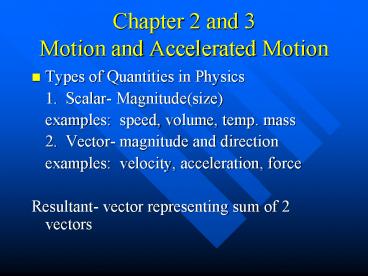Chapter 2 and 3 Motion and Accelerated Motion - PowerPoint PPT Presentation
1 / 21
Title:
Chapter 2 and 3 Motion and Accelerated Motion
Description:
Motion and Accelerated Motion Types of Quantities in Physics 1. Scalar- Magnitude(size) ... Resultant- vector representing sum of 2 vectors – PowerPoint PPT presentation
Number of Views:409
Avg rating:3.0/5.0
Title: Chapter 2 and 3 Motion and Accelerated Motion
1
Chapter 2 and 3Motion and Accelerated Motion
- Types of Quantities in Physics
- 1. Scalar- Magnitude(size)
- examples speed, volume, temp. mass
- 2. Vector- magnitude and direction
- examples velocity, acceleration, force
- Resultant- vector representing sum of 2 vectors
2
Time intervals and Displacement
- Time Interval- difference between 2 times
- ? ? change in a quantity
- ?t tf-ti
- Displacement- change in position
- ?d
3
Position-Time Graphs
- Can be used to find the velocity and position of
an object
4
Velocity
- Speed in a given direction
- What type of quantity is velocity?
- Vector
- Average Velocity(v) ?d/ ?t or
- df-di/tf-ti
- Instantaneous Velocity- speed and direction at
a particular instant - example speedometer
?
5
Determining position with average velocity
- dvt di or
- dvt if di 0
6
Ch. 3Accelerated Motion
- What is acceleration?
- - rate of change of velocity
- a vf - vi / t or a ?v / ?t
- measured in m/s2
- http//www.glenbrook.k12.il.us/gbssci/phys/mmedia/
kinema/acceln.html
7
Types of Acceleration
- Constant acceleration- velocity changes at a
constant rate - Instantaneous acceleration- change in velocity at
an instant of time - Deceleration- negative acceleration
8
Motion with Constant Acceleration
- Final velocity with average acceleration
- a ?v / ?t
- a ?t vf vi
- vf vi a ?t
9
Examples(p.65)
- 18a. A golf ball rolls up a hill toward a
miniature-golf hole. Assume that the direction
toward the hole is positive. If the golf ball
starts with a speed of 2.0 m/s and slows at a
constant rate of .50 m/s/s, what is its velocity
after 2.0 s?
10
Example(p.65)
- 20. If a car accelerates from rest at a constant
5.5 m/s/s, how long will it take for the car to
reach a velocity of 28 m/s?
11
B. Position with average acceleration
- d vit ½ at2
- Example A car starting from rest is accelerated
at 6.1 m/s/s. What is the cars displacement
during the first 7.0 s of acceleration?
12
What is the difference between displacement and
distance?
- Distance is a scalar quantity which refers to
"how much ground an object has covered" during
its motion. - Displacement is a vector quantity which refers to
"how far out of place an object is" it is the
object's overall change in position. - To test your understanding of this distinction,
consider the motion depicted in the diagram
below. A physics teacher walks 4 meters East, 2
meters South, 4 meters West, and finally 2 meters
North.
13
C. Velocity with Constant Acceleration
- vf2 vi2 2ad
- Example A plane is accelerated from a speed of
2.0 m/s at the constant rate of 3.0 m/s/s over a
distance of 530 m. What is its speed after
traveling this distance?
14
D. Displacement(Position) during Uniform
Acceleration
- d ½ ( vf vi) t
- Example A race car traveling south at 44 m/s is
uniformly decelerated to a velocity of 22 m/s
over an 11 second interval. What is its
displacement during this time?
15
What is Kinematics?
- The mathematical description of motion
- The science of describing the motion of objects
using words, diagrams, numbers, graphs, and
equations.
16
Example(p. 71)
- A man runs at a velocity of 4.5 m/s for 15.0 min.
When going up an increasingly steep hill, he
slows down a constant rate of 0.05 m/s/s for 90.0
s and comes to a stop. How far did he run? - Hint This requires two steps.
17
Example( p. 71)
- 32. You start your bicycle at the tip of a hill.
You coast down the hill at a constant
acceleration of 2.00 m/s/s. When you get to the
bottom of the hill, you are moving at 18.0 m/s,
ad you pedal to maintain that speed. If you
continue at this speed for 1.00 min., how far
will you have gone from the time you left the
hilltop?
18
Free Fall
- Free Fall
- The motion of a body when air resistance is
negligible and the motion can be considered due
to the force of gravity
19
Acceleration due to Gravity
- Acceleration of an object in free fall that
results from Earths gravity - Has the symbol g
- g 9.8 m/s/s ( average value)
- It is a positive number
- If your coordinate system defines upward to be
the positive direction, then acceleration due to
gravity is g and vice versa. - So in other words a -g or ag.
20
Examples p.74
- 42. A construction worker accidentally drops a
brick from a high scaffold. - What is the velocity of the brick after 4.0 s?
- How far does the brick fall during this time?
21
More examples
- 45. A tennis ball is thrown straight up with an
initial speed of 22.5 m/s. It is caught at the
same distance above the ground. - a. How high does the ball rise?
- b. How long does the ball remain in the air?































